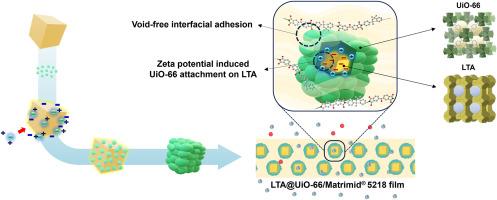通过表面zeta电位调制和沸石/聚合物复合膜的有序种子生长,制备LTA沸石核心和UiO-66外壳结构
IF 4.8
3区 材料科学
Q1 CHEMISTRY, APPLIED
引用次数: 0
摘要
由于沸石的独特性能,沸石基聚合物复合材料在分离、催化和能量存储方面的应用备受关注。核壳结构的开发为增强这些特性提供了一种前景广阔的策略,可对复合薄膜内的沸石特性进行微调。在本研究中,我们提出了一种创新方法,利用表面 zeta 电位差促进亲有机金属有机框架 (MOF) 在亲水性沸石表面的生长。具体来说,UiO-66 成功附着并生长在林德 A 型(LTA)沸石颗粒上,从而形成了一种坚固的核壳结构(LTA@UiO-66)。当这种核壳结构嵌入聚酰亚胺(PI,Matrimid® 5218)基质时,可大大减少界面空隙,从而产生具有优异机械完整性和更强气体分离性能的复合薄膜(LTA@UiO-66/PI)。LTA@UiO-66/PI 薄膜对 O2/N2(10.7)和 CO2/CH4(47)表现出显著的理想选择性,优于传统的 LTA/PI 复合材料。这些改进归功于 LTA 内核和 UiO-66 外壳之间的协同效应,在保持沸石分子筛分能力的同时,确保了与聚合物基体之间的强粘附性和无空隙界面。这些发现强调了基于沸石的核壳结构在推进工业应用方面的巨大潜力,特别是在可持续气体分离和净化技术领域。本文章由计算机程序翻译,如有差异,请以英文原文为准。

Fabrication of LTA zeolite core and UiO-66 shell structures via surface zeta potential modulation and sequential seeded growth for zeolite/polymer composite membranes
Zeolite-based polymer composites have garnered significant attention for their applications in separation, catalysis, and energy storage, owing to the unique properties of zeolites. The development of core–shell structures provides a promising strategy to enhance these properties, enabling the fine-tuning of zeolite characteristics within composite films. In this study, we present an innovative approach that leverages surface zeta potential differences to facilitate the growth of an organophilic metal–organic framework (MOF) on hydrophilic zeolite surfaces. Specifically, UiO-66 was successfully attached and grown on Linde Type A (LTA) zeolite particles, resulting in the formation of a robust core–shell structure (LTA@UiO-66). This core–shell architecture significantly minimized interfacial voids when embedded into a polyimide (PI, Matrimid® 5218) matrix, yielding composite films (LTA@UiO-66/PI) with superior mechanical integrity and enhanced gas-separation performance. The LTA@UiO-66/PI films demonstrated remarkable ideal selectivity for O2/N2 (10.7) and CO2/CH4 (47), outperforming traditional LTA/PI composites. These enhancements are attributed to the synergistic effects between the LTA core and the UiO-66 shell, which preserve the molecular sieving capability of the zeolite while ensuring strong adhesion and a void-free interface with the polymer matrix. The findings underscore the significant potential of zeolite-based core–shell structures in advancing industrial applications, particularly in the domains of sustainable gas separation and purification technologies.
求助全文
通过发布文献求助,成功后即可免费获取论文全文。
去求助
来源期刊

Microporous and Mesoporous Materials
化学-材料科学:综合
CiteScore
10.70
自引率
5.80%
发文量
649
审稿时长
26 days
期刊介绍:
Microporous and Mesoporous Materials covers novel and significant aspects of porous solids classified as either microporous (pore size up to 2 nm) or mesoporous (pore size 2 to 50 nm). The porosity should have a specific impact on the material properties or application. Typical examples are zeolites and zeolite-like materials, pillared materials, clathrasils and clathrates, carbon molecular sieves, ordered mesoporous materials, organic/inorganic porous hybrid materials, or porous metal oxides. Both natural and synthetic porous materials are within the scope of the journal.
Topics which are particularly of interest include:
All aspects of natural microporous and mesoporous solids
The synthesis of crystalline or amorphous porous materials
The physico-chemical characterization of microporous and mesoporous solids, especially spectroscopic and microscopic
The modification of microporous and mesoporous solids, for example by ion exchange or solid-state reactions
All topics related to diffusion of mobile species in the pores of microporous and mesoporous materials
Adsorption (and other separation techniques) using microporous or mesoporous adsorbents
Catalysis by microporous and mesoporous materials
Host/guest interactions
Theoretical chemistry and modelling of host/guest interactions
All topics related to the application of microporous and mesoporous materials in industrial catalysis, separation technology, environmental protection, electrochemistry, membranes, sensors, optical devices, etc.
 求助内容:
求助内容: 应助结果提醒方式:
应助结果提醒方式:


